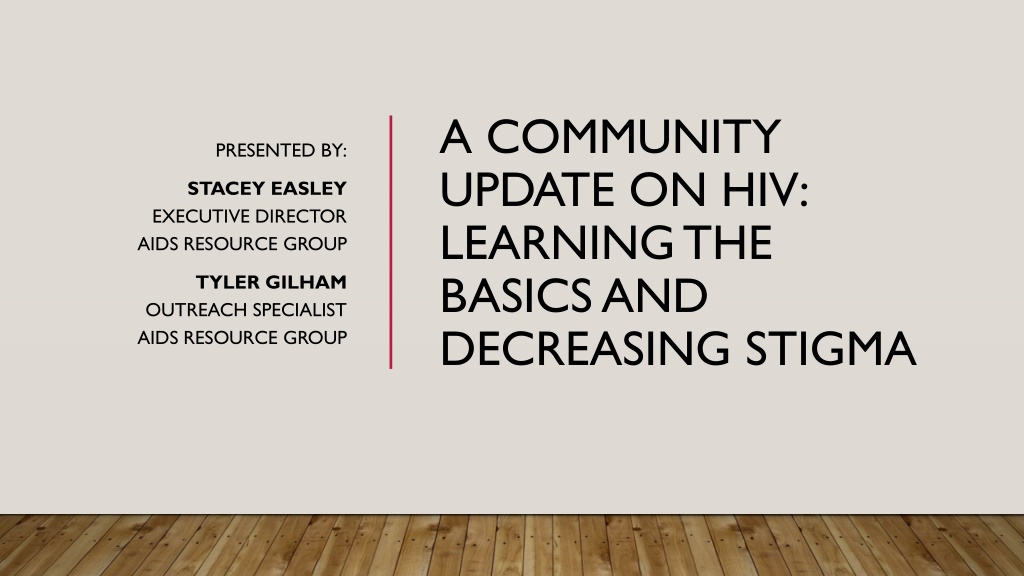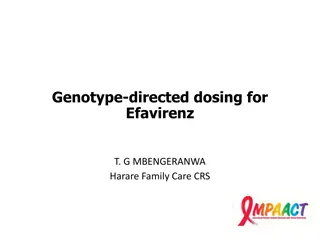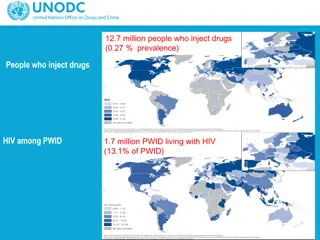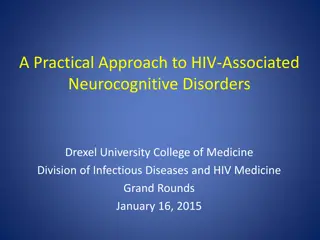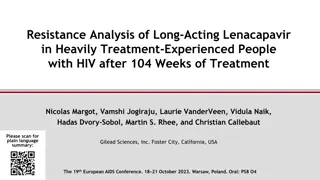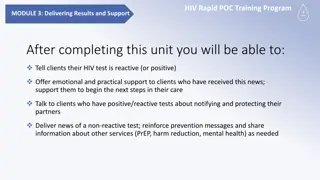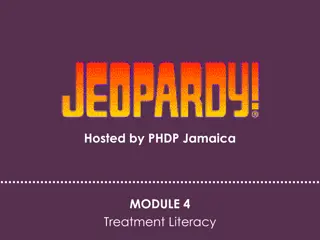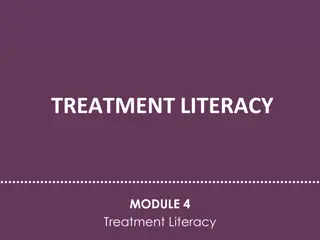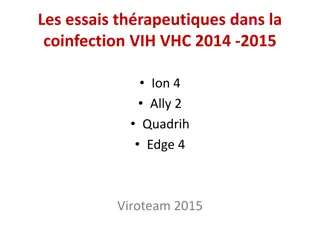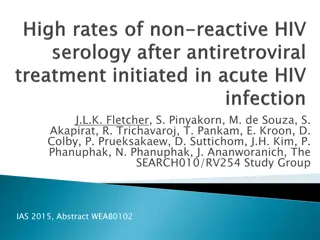Understanding HIV: Basics, Stages, and Treatment
HIV, Human Immunodeficiency Virus, attacks the immune system and can progress to AIDS if left untreated. Antiretroviral Therapy (ART) helps control HIV, allowing individuals to live healthy lives. The stages of HIV include Acute Infection, Chronic Infection, and the most severe stage, AIDS. Early detection and proper medical care are crucial for managing HIV effectively and reducing transmission.
Download Presentation

Please find below an Image/Link to download the presentation.
The content on the website is provided AS IS for your information and personal use only. It may not be sold, licensed, or shared on other websites without obtaining consent from the author. Download presentation by click this link. If you encounter any issues during the download, it is possible that the publisher has removed the file from their server.
E N D
Presentation Transcript
A COMMUNITY UPDATE ON HIV: LEARNING THE BASICS AND DECREASING STIGMA PRESENTED BY: STACEY EASLEY EXECUTIVE DIRECTOR AIDS RESOURCE GROUP TYLER GILHAM OUTREACH SPECIALIST AIDS RESOURCE GROUP
AIDS RESOURCE GROUP 101 North West 1stStreet, Suite 213 Evansville, IN 47708 (812) 421-0059 www.argevansville.org www.facebook.com/aidsresourcegroup/ www.arg.as.me Schedule free test director@argevansville.org Stacey s email tgilham@argevansville.org Tyler s email
HIV Hepatitis C Syphilis TODAY S TOPICS: ARG Programs and Services Harm Reduction ARG Community Involvement
HIV (Human Immunodeficiency Virus) is a virus that attacks the body s immune system. Left untreated, HIV can lead to AIDS (Acquired Immunodeficiency Syndrome). There is currently no effective cure. Once people are infected with HIV, they will have it for life. HIV: BASICS With proper medical care, HIV can be controlled. People with HIV who get effective HIV treatment can live long, healthy lives. HIV treatment is called Antiretroviral Therapy or ART U=U, Undetectable = Untransmittable
Stage 1: Acute HIV Infection First month of infection (2-4 weeks). People have a large amount of HIV in their blood and are very contagious. HIV: STAGE 1 May experience flu like symptoms. Fever, sore throat, chills, fatigue Not likely to be found through HIV testing Most people would NOT test positive until after 27 days if testing for HIV antibodies.
Stage 2: Chronic HIV Infection Also called asymptomatic HIV infection or clinical latency. HIV still active and reproducing in the body. People often have no symptoms or get sick during this phase. Transmission is still possible. This stage may last a decade or may progress faster to stage 3. People who take HIV treatment may never move onto Stage 3. HIV: STAGE 2
Stage 3: Acquired Immunodeficiency Syndrome ( AIDS) Most severe stage of HIV infection Viral load can be high and may easily transmit HIV to others. People with AIDS have badly damaged immune systems. This leads to an increasing number of opportunistic infections or other serious illnesses. Without HIV treatment, people with AIDS typically survive about three years. HIV: STAGE 3
HIV: TRANSMISSION You can get or transmit HIV only through specific activities. Most commonly, people get or transmit HIV through sexual behaviors or injection drug use. Only certain body fluids can transmit HIV. Bodily fluids that transmit HIV: Blood Semen Pre-seminal fluid Vaginal fluid These fluids must meet a mucous membrane or damaged tissue or be directly injected into the blood stream for transmission to occur. Rectal fluid Breast milk Spinal Fluid
HIV: TREATMENT HIV treatment involves taking medicine as prescribed by a health care provider. HIV treatment reduces the amount of HIV in your body and helps you stay healthy. Treatment Types: Pill recommended for people just starting HIV treatment, many approved single pill and combination medicines available. Shots long-acting injections, once a month or once every other month. Most people get the virus under control within six months. Risk of HIV drug resistance is possible.
HIV PREVENTION Abstinence (not having sex) Choose sexual activities with little to no risk Limiting your number of sexual partners HIV prevention medicines Pre-exposure prophylaxis (PrEP) Post-exposure prophylaxis (PEP) Using condoms the right way every time you have sex Never sharing needles or injection equipment
Nearly all pregnant women today get an HIV test as part of their prenatal care. Babies born to HIV+ mothers are given ART by mouth for 6 weeks and are tested for HIV at birth, 2 weeks, 4 weeks, 4 months, & 18 months.
DUTY TO INFORM These Indiana Laws (IC 16-41-7-1 and IC 35-45-21-1, 3) state that: People living with HIV are legally required to share their HIV status with people whom they have engaged, or will engage, in sexual or needle sharing activities that can transmit HIV.* People living with HIV may not sell, transfer, or donate blood, plasma, or semen for artificial insemination. Violations can lead to criminal penalties. * Activities in the code means sexual or needle sharing contact that has been epidemiologically demonstrated, as determined by the federal Centers for Disease Control and Prevention, to bear a significant risk of transmitting HIV (IC 16-41-7-1(b)).
HIV TESTING Testing Guidelines/ Info: There is a window period detection outside first 27 days. It usually takes about a month before HIV antibodies are detected. About 97% of people develop HIV antibodies within 3 months and will likely show up on a test. At 6 months post exposure, 100% of people that would be HIV+, would show positive at this point. Out of all people infected with HIV, only about 88% know their status. *Free instant HIV testing available at ARG, results in 2 minutes!* www.arg.as.me to schedule an appointment
HEPATITIS C VIRUS (HCV) Hepatitis C (HCV) is a blood-borne virus. Transmission: sharing needles, unregulated tattooing, blood on blood contact. For some (15%-30%), HCV is short term illness, or Acute HCV Infection. For others (70%-85%), HCV becomes long-term, or Chronic HCV Infection. HCV can lead to serious health complications and even death. Cirrhosis and liver cancer Many people might not be aware of their infection because they are not clinically ill or have no signs or symptoms. Testing: HCV antibodies usually detected 8-11 weeks after exposure. There is no vaccine for HCV, but there is a cure. Over 90% of people with HCV can be cured with 8-12 weeks of direct-acting antiviral (DAA)
Syphilis is a STD that can have very serious complications when left untreated, but it is simple to cure with the right treatment. Syphilis is divided into stages of primary, secondary, latent, and tertiary. SYPHILIS Syphilis is spread by direct contact with a syphilis sore during vaginal, anal, or oral sex. Sores can be found on or around the penis, vagina, anus, rectum, lips, or mouth. Can also be spread from an infected mother to her unborn baby.
SYPHILIS Primary stage: Single or multiple sores, sore is usually firm, round, and painless. Sore last 3-6 weeks and heals regardless of whether treatment is received. Even if sore goes away treatment is still required. Latent stage: No signs or visible symptoms. Tertiary stage: Tertiary syphilis is very serious and would occur 10 30 years after your infection began. In tertiary syphilis, the disease damages your internal organs and can result in death. Secondary stage: Skin rashes or mucous membrane lesions in mouth, vagina, and/or anus. The rash would look rough, red or reddish-brown, appear on palms of hands or bottom of feet. Rashes start when primary sores start to heal or several weeks after. Treatment: Syphilis is curable with the right antibiotics; however treatment might not undo any damage the infection can cause.
AIDS RESOURCE GROUP SERVICES: HIV SERVICES Client Eligibility Ryan White Part B Supplemental Programs HIV positive Non-Medical Case Management Insurance Enrollment IN resident Psychosocial 300% poverty Food Pantry Recertify every 6 months Medical Nutritional Therapy Emergency Financial Assistance-Housing & Utility
AIDS RESOURCE GROUP SERVICES: HIV SERVICES Housing Opportunities for Persons with AID Direct Emergency Financial Assistance (DEFA) (HOPWA) Bus tokens/passes Long-term rental assistance Graceful Giving Short-term rental, mortgage, and utility assistance Household supplies Emergency housing placement Deposits
AIDS RESOURCE GROUP SERVICES: Free Counseling Harm Reduction Supplies Insurance/SNAP Enrollment Risk Reduction Supplies Prevention Education Free Testing Services HIV Health Fairs HEP C Community Events Syphilis Community Clean-up Referrals LGBTQ+ Advocacy
HARM REDUCTION Harm Reduction = a set of practical strategies and ideas aimed at reducing negative consequences. Incorporates a spectrum of strategies that includes safer use, managed use, abstinence, meeting people who use drugs where they re at, and addressing conditions of use along with the use itself. Harm Reduction Examples: Sunscreen Designated Drivers Bug Spray Naloxone Seatbelts Syringe Service Programs Helmets Condoms PrEP
NATIONAL HARM REDUCTION COALITION: PRINCIPLES CENTRAL TO HARM REDUCTION 2. Understand drug use as a complex, multifaceted phenomenon that encompasses a continuum of behaviors from severe use to total abstinence and acknowledges that some ways of using drugs are clearly safer than others. 1. Accepts, for better or worse, that licit and illicit drug use is part of our world and chooses to work to minimize its harmful effects rather than simply ignore or condemn them.
NATIONAL HARM REDUCTION COALITION: PRINCIPLES CENTRAL TO HARM REDUCTION 4. Calls for the non-judgmental, non-coercive provision of services and resources to people who use drugs and the communities in which they live in order to assist them in reducing attendant harm. 3. Establishes quality of individual and community life and well-being, not necessarily cessation of all drug use as the criteria for successful interventions and policies.
NATIONAL HARM REDUCTION COALITION: PRINCIPLES CENTRAL TO HARM REDUCTION 6. Affirms people who use drugs (PWUD) themselves as the primary agents of reducing the harms of their drug use and seeks to empower PWUD to share information and support each other in strategies which meet their actual conditions of use. 5. Ensures that people who use drugs and those with a history of drug use routinely have a real voice in the creation of programs and policies designed to serve them.
NATIONAL HARM REDUCTION COALITION: PRINCIPLES CENTRAL TO HARM REDUCTION 7. Recognizes that the realities of poverty, class, racism, social isolation, past trauma, sex-based discrimination, and other social inequalities affect both people s vulnerability to and capacity for effectively dealing with drug-related harm. 8. Does not attempt to minimize or ignore the real and tragic harm and danger that can be associated with illicit drug use.
ARG: HARM REDUCTION HEPATITIS C HARM REDUCTION Safer Injection Kits HIV/SYPHILIS HARM REDUCTION Free condoms Multiple Types Everything but needle/syringe External/ Internal Condoms Safer Smoking Kits Latex vs. Latex-Free Wound Care Kits Personal Lubricant Sharps Containers Condom Kits Narcan/ Naloxone Condom Case Fentanyl Test Strips PrEP* Lip Balm *Offered through partner clinic, Matthew 25 HIV/STD Education Harm Reduction Education
ARG: COMMUNITY INVOLVEMENT Health Fairs Public Events Lemonade Stands ARG Sponsored Events Outreach Testing Educational Services Region 8 ZIP
AIDS RESOURCE GROUP 101 North West 1st Street, Suite 213 Evansville, IN 47708 (812) 421-0059 www.argevansville.org www.facebook.com/aidsresourcegroup/ www.arg.as.me Schedule free test director@argevansville.org Stacey s email tgilham@argevansville.org Tyler s email
POST-TEST Please scan this QR code to take our short post- test *QR CODE*
